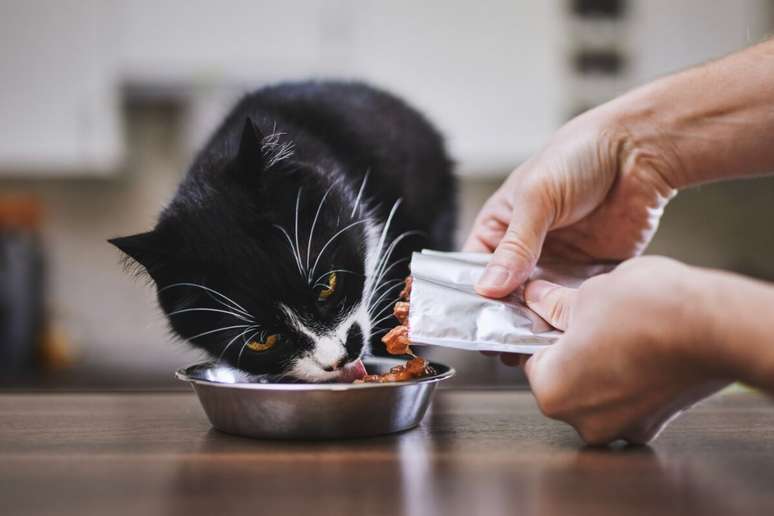Find out how to guarantee a healthier diet, more balanced and tasty for your feline with the right choice of wet food
The cat’s feeding goes far beyond the filling of the pot of any diet. It requires aware care and choices, since a balanced diet is essential to maintain the health, arrangement and longevity of the feline. In this scenario, the sachet – also called wet nutrition – has distinguished itself as a nourishing alternative, practical and highly attractive to the complement or even replace dry nutrition in certain situations.
In addition to welcome even the most demanding cats, the sachet is rich in humidity, a factor that helps to hydrate the animal. This is particularly important because the felines, on instinct, tend to drink little water during the day. The lack of adequate hydration can favor the emergence of urinary and kidney diseases.
“Many cats do not ingest enough water spontaneously, which can affect their urinary health. Therefore, associating wet foods with dry diet is a great way to ensure greater intake of water, helping to prevent urinary problems such as famous bladder calculations, […]”Guides Mayara Andrade, GranPlus (Brf Pet) Veterinary Doctor.
To help you make the best choice, take a look at some essential tips to choose the ideal sachet and guarantee greater health and quality of life for your cat!
1. Check that the sachet is complete or simply complementary
Not every sachet is made to be the meal Main cat. Some are classified as complete foods, that is, they contain all the nutrients necessary to meet the daily needs of the animal. Others are only complementary, indicated to be used as a snack or reinforcement in food. This information is always described in the package. You should opt for a complete envelope if wet food is often offered or as the main power supply.
2. Carefully analyze the list of ingredients
The composition of the sachet reveals a lot on its nutritional quality. Ideally, the protein of animal origin (such as chicken, fish or beef) appears among the first ingredients on the list. Avoid those who contain many for -products, generic meat flour or free ingredients such as “meat and derivatives”. More specific and natural is the source of protein, the better the digestibility and use of nutrients by the cat.
3. Avoid foods with artificial preservatives, dyes and additives
Many sachets on the market contain chemicals that can compromise Cat health In the long term, such as artificial dyes, synthetic aromas and aggressive preservatives. These substances can cause food allergies, digestive problems or even overload the liver and the kidneys. Always prefer foods with more natural, transparent and free formulations of these unnecessary additives.
4. Choose the sachet based on the age and needs of your cat
Cats, adults and the elderly have different nutritional needs, which must be respected during the choice. For example, puppies need more calories, football and proteins for healthy growth. Elderly cats may need lighter foods with specific nutrients for the health of kidneys or joints.
Furthermore, if the cat has health conditions, such as obesity, digestive sensitivity or kidney disease, it is essential to choose a specific sachet for this picture, always by veterinary recommendation.
5. Observe the plot and type of presentation
Cats are demanding and selective animals when it comes to consistency. There are sachets in the shape of pieces in the sauce, pati, jelly flakes, stripes or natural chips. Some prefer the most pasty pate, while others better accept the pieces in the sauce.
Testing different options helps to understand the animal’s preferences. “Of course, in addition to the flavors, we should take into account their individual preference, but usually humid foods, regardless of the consistency, due to the composition, which combines the taste and high humidity, are very interesting for pets generally. But we have to remember it preferably cats They have a predilection for different textures offered separately, unlike dogs that have a predilection for different plots together “, explains the veterinary doctor Mayara Andrade.

6. From preference to high humidity sachets
One of the major advantages of the sachet is its water content, which usually varies between 75% and 85%. This high humidity content is important to help with the hydration of cats, especially if it drinks little water on a daily basis. The ingestion of liquids through food reduces the risk of formation of urinary crystals, calculation of kidneys and infections in the urinary tract. Therefore, humidity should be a criterion of choice, in particular castrated cats or with history of kidney problems.
7. Beware of sodium content and minerals
Excessive sodium, phosphorus or other minerals can compromise the health of cats, especially in cases of animals with heart disease, hypertension or kidney problems. When choosing the sachet, it is important to check the nutritional table And look for versions with low quantity of sodium and the correct balance of minerals. This choice helps to preserve vital organs and promotes the correct functioning of the feline body.
8. You prefer trademarks recognized with good reputation
Opt for reliable brands is a way to ensure that food undergoes rigorous quality controls. It should be verified if the company responsible for the sachet follows the rules established by the Ministry of Agriculture (MAPA), if it has a good reputation on the market and receives good assessments from other tutors. Consolidated brands often invest in research, nutrition and food safety, which offers the tutor more tranquility.
9. See the vet before changing the cat’s diet
Changing the type of diet without a guide can cause digestive problems, refusal or nutritional imbalance. Therefore, before inserting the sachet into the routine or of the changing brand, it is important to speak with the vet.
“Ideally, the tutor always looks for the veterinarian To define the most suitable food, the correct quantity and perform check Periodicals “, recommends Mayara Andrade. It can evaluate the health of the animal, indicate the best sachet option and guide the correct amount to offer, guaranteeing a safe and gradual process.
10. Note how the cat reacts to the new food
After offering the sachet, pay attention to the acceptance and behavior of Cat. If the animal eats with enthusiasm, keeping the appetite and with normal stools, it is a sign that the food has been welcome. On the other hand, symptoms such as vomiting, diarrhea, itching or refusal can indicate intolerance or allergy and it is necessary to suspend use and look for a professional guide.
Source: Terra
Ben Stock is a lifestyle journalist and author at Gossipify. He writes about topics such as health, wellness, travel, food and home decor. He provides practical advice and inspiration to improve well-being, keeps readers up to date with latest lifestyle news and trends, known for his engaging writing style, in-depth analysis and unique perspectives.








